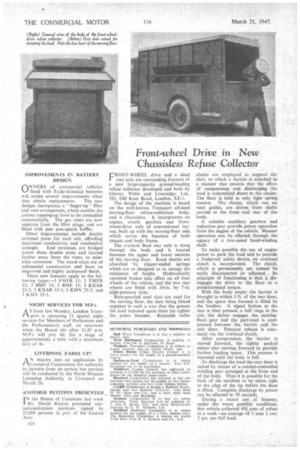Front-wheel Drive in New
Page 32

If you've noticed an error in this article please click here to report it so we can fix it.
Chassis less Refuse Collector
IMPROVEMENTS IN BATTERY DESIGN
nWNERS of commercial vehicles 1---/ fitted with Exide-Ironclad batteries will notice several improvements when
• they obtain replacements. The new designs incorporate a finger-tip" filler and vent arrangement, which enables the correct topping-tip level to be controlled automatically. The gas vents are now separate from the filler plugs, and are fitted With new non-splash baffles. Other improvements include double terminal posts for each cell, affording • maximum conductivity and mechanical
strength. End terminals are bridged across these, double posts and located farther away from the vents, to minimize corrosion. The wood .trays are of substantial construction and have an 'improved and highly acid-proof finish. These new features apply to the following types:-3 FMFR 11; 3 FNIFR 13; 3 BMF 11; 3 IIMF 13; 3 KXAR 23-2: 3 KXAR 15-1; 3 KMV 23-2; and 3 KMV 15-1.
NIGHT SERVICES FOR M.P.s
.1-1. A m S from last Monday. London Trans port is operating 11 special night services for Members of Parliament and the Parliamentary staff, on occasions when the House sits after 11.45 pin. M.P.s will pay 6d. for a stage of approximately a mile, with a maximum, fare of 4s;
LIVERPOOL FARES UP?
ANinquiry into an application by Liverpool Corporation for authority to *tease fares on certain bus services will be conducted by the North Western Licensing Authority in Liverpool on March 26.
ANOTHER PETMON PRESENTED I N the House of Commons last week Mr. David Renton presented antinationalization petitions signed by 27.000 persons in part of the Eastern Area. VRONT-WHEEL drive and a dead 1 rear axle are outstanding features of a new large-capacity ground-loading refuse collector developed and built by Glover, Webb and Liversidge, Ltd., 561, Old Kent Road, London, S.E.1.
The design of the machine is based on the well-known Transport all-steel moving-floor refuse-collection body, and is chassisless. It incorporates an engine, clutch, gearbox and frontwheel-drive axle of conventional layout, built up with the moving-floor unit which serves the function of both chassis and body frame.
The cranked dead rear axle is slung through the body and is located between the upper and lower sections of the moving floor. Road shocks are absorbed by slipper-ended springs which are so designed as to occupy the minimum of height. Hydraulically operated brakes take effect on all four wheels of the vehicle, and the two rear wheels are fitted with 34-in. by 7-in. high-pressure tyres.
Rust-proofed steel slats are used for the moving floor, the slats being linked together in such a way that the greater the load imposed upon them the tighter the joints become, Reynolds roller chains are employed to support the slats, to which a barrier is attached in a manner that ensures that the effort of compressing and discharging .the load is transmitted direct to the chains. The floor is held in only light spring tension. The chains, which run on steel guides, are driven from shafts carried at the front and rear of the body.
A suitable auxiliary gearbox and reduction gear provide power operation from the engine of the vehicle. Manual Operation can be effected through the agency of a two-speed hand-winding
To make possible the use of engine power to pack the load and to provide a foolproof safety device, an overload clutch is incorporated. The clutch, which is permanently set, cannot be easily disconnected or adjusted. Its principle of functioning is that it .disengages the drive to the. floor at a predetermined torque.
With the body empty the barrier is brought to within 3 ft. of the rear door, and the space thus formed is filled by the loaders. A signal button at the rear is then pressed, a belt rings in the cab, the driver erigages the movingfloor gear and the part-load is cornpressed between the barrier and the rear door. Pressure release is automatic via the overload clutch.
After compression, the 'barrier is moved forward, the tightly packed refuse also moving forward to provide further loading space. This process is repeated until the body is full.
To discharge the load the rear door is raised by means of a-ratchet-controlled winding gear arranged at the front end of the body. Thus it is possible for the back of the machine to be taken right to the edge of the tip before the door is lifted. Complete discharge by power can be effected in 30 seconds,_ During a recent testat Stepney, under the worst possible conditions, this vehicle collected 49* tons of refuse in a week—an average of 3 tons 2 cwt. 2 qrs. per full load.












































































